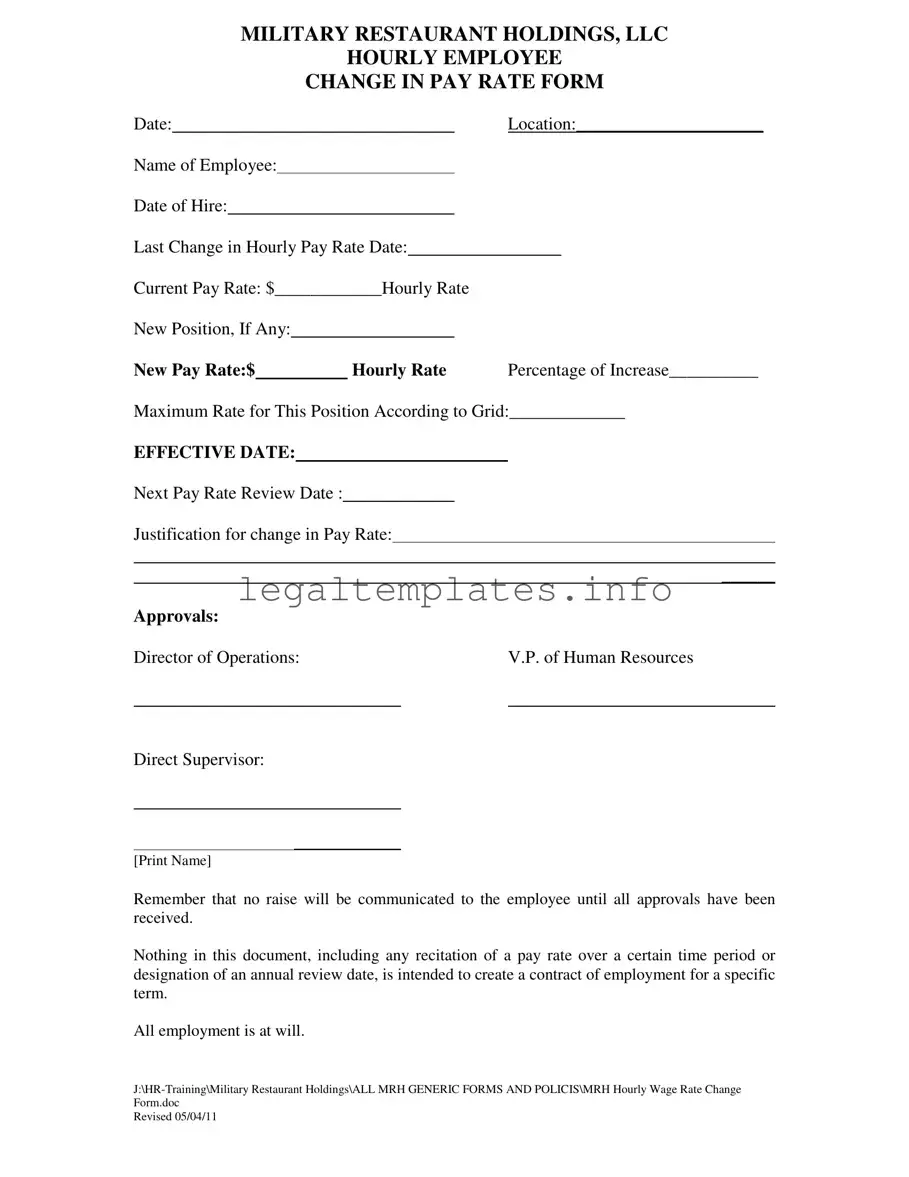The "Employee Information Update Form" is similar to the "Change Pay Rate Form" because it also collects critical changes related to an employee's status. Whereas the Change Pay Rate Form focuses on adjustments in compensation, the Employee Information Update Form gathers data such as changes in personal information, contact details, or emergency contacts. Both forms play a vital role in keeping employee records accurate and up to date, ensuring that all employment-related documents reflect the current situation.
The "Promotion or Transfer Form" aligns closely with the Change Pay Rate Form, as both deal with changes in an employee’s status that might affect their compensation. The Promotion or Transfer Form is used when an employee moves to a different position or department within the company, detailing the new role, responsibilities, and sometimes the new pay rate. It shares the common purpose of documenting significant career milestones and adjustments in an employee's terms of employment.
A "Performance Review Form" bears resemblance to the Change Pay Rate Form in that a positive review could result in a pay increase. Performance Review Forms are used to assess an employee's job performance over a certain period, providing a structured feedback mechanism. Pay rate changes often ensue as a result of the outcomes noted in these reviews, making the connection between performance assessments and salary adjustments explicit.
The "Job Offer Letter" closely relates to the Change Pay Rate Form because it typically specifies starting compensation for a new position, which sets the baseline for future pay rate changes. A job offer letter marks the beginning of an employment relationship, detailing the terms of employment, including job description, salary, and benefits. Any subsequent changes to these terms, such as a pay increase, would necessitate the use of a Change Pay Rate Form.
The "Employee Exit Form" indirectly correlates with the Change Pay Rate Form as it documents the end of an employee’s tenure at a company, including their last pay rate. While the Change Pay Rate Form is used for adjustments during employment, the Employee Exit Form captures final employment details, including reasons for leaving and final salary. Both forms are essential for maintaining accurate employment records and analyzing trends in employment lifecycle events.
"Time-off Request Forms" intersect with the Change Pay Rate Form through their impact on payroll processing. While time-off requests document absences, the Change Pay Rate Form records adjustments to what might be an hourly rate, affecting overall earnings. Both types of documentation feed into payroll calculations, ensuring that employees are compensated accurately according to their working hours and agreed rates of pay.
The "Direct Deposit Authorization Form" parallels the Change Pay Rate Form in its contribution to the payroll process. The Direct Deposit Form gathers banking information for salary disbursement, ensuring that employees receive their paychecks promptly and securely. Any change in pay rate documented by the Change Pay Rate Form would subsequently be reflected in the amounts processed through the information supplied on the Direct Deposit Authorization Form.
An "Annual Salary Review Form" is akin to the Change Pay Rate Form, as both involve considerations about pay adjustments. While the Change Pay Rate Form might be used any time a pay rate change is warranted, the Annual Salary Review Form is specifically used once a year to evaluate whether an employee’s salary is aligned with their performance, market rates, and company budgets. Both forms are instrumental in ensuring fair and competitive compensation practices.
Lastly, the "Benefits Enrollment or Change Form" shares similarities with the Change Pay Rate Form due to its role in documenting changes that affect an employee’s total compensation package. Changes in pay often lead to reevaluation of benefits eligibility or levels, especially for benefits that are tied to salary, such as certain life insurance coverage amounts. Both forms are crucial for administering accurate and appropriate compensation and benefits to employees.

